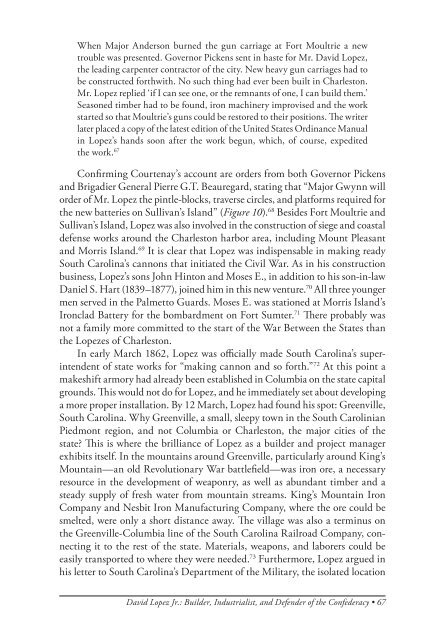American Jewish Archives Journal, Volume 64, Numbers 1 & 2
American Jewish Archives Journal, Volume 64, Numbers 1 & 2
American Jewish Archives Journal, Volume 64, Numbers 1 & 2
Create successful ePaper yourself
Turn your PDF publications into a flip-book with our unique Google optimized e-Paper software.
When Major Anderson burned the gun carriage at Fort Moultrie a new<br />
trouble was presented. Governor Pickens sent in haste for Mr. David Lopez,<br />
the leading carpenter contractor of the city. New heavy gun carriages had to<br />
be constructed forthwith. No such thing had ever been built in Charleston.<br />
Mr. Lopez replied ‘if I can see one, or the remnants of one, I can build them.’<br />
Seasoned timber had to be found, iron machinery improvised and the work<br />
started so that Moultrie’s guns could be restored to their positions. The writer<br />
later placed a copy of the latest edition of the United States Ordinance Manual<br />
in Lopez’s hands soon after the work begun, which, of course, expedited<br />
the work. 67<br />
Confirming Courtenay’s account are orders from both Governor Pickens<br />
and Brigadier General Pierre G.T. Beauregard, stating that “Major Gwynn will<br />
order of Mr. Lopez the pintle-blocks, traverse circles, and platforms required for<br />
the new batteries on Sullivan’s Island” (Figure 10). 68 Besides Fort Moultrie and<br />
Sullivan’s Island, Lopez was also involved in the construction of siege and coastal<br />
defense works around the Charleston harbor area, including Mount Pleasant<br />
and Morris Island. 69 It is clear that Lopez was indispensable in making ready<br />
South Carolina’s cannons that initiated the Civil War. As in his construction<br />
business, Lopez’s sons John Hinton and Moses E., in addition to his son-in-law<br />
Daniel S. Hart (1839–1877), joined him in this new venture. 70 All three younger<br />
men served in the Palmetto Guards. Moses E. was stationed at Morris Island’s<br />
Ironclad Battery for the bombardment on Fort Sumter. 71 There probably was<br />
not a family more committed to the start of the War Between the States than<br />
the Lopezes of Charleston.<br />
In early March 1862, Lopez was officially made South Carolina’s superintendent<br />
of state works for “making cannon and so forth.” 72 At this point a<br />
makeshift armory had already been established in Columbia on the state capital<br />
grounds. This would not do for Lopez, and he immediately set about developing<br />
a more proper installation. By 12 March, Lopez had found his spot: Greenville,<br />
South Carolina. Why Greenville, a small, sleepy town in the South Carolinian<br />
Piedmont region, and not Columbia or Charleston, the major cities of the<br />
state? This is where the brilliance of Lopez as a builder and project manager<br />
exhibits itself. In the mountains around Greenville, particularly around King’s<br />
Mountain—an old Revolutionary War battlefield—was iron ore, a necessary<br />
resource in the development of weaponry, as well as abundant timber and a<br />
steady supply of fresh water from mountain streams. King’s Mountain Iron<br />
Company and Nesbit Iron Manufacturing Company, where the ore could be<br />
smelted, were only a short distance away. The village was also a terminus on<br />
the Greenville-Columbia line of the South Carolina Railroad Company, connecting<br />
it to the rest of the state. Materials, weapons, and laborers could be<br />
easily transported to where they were needed. 73 Furthermore, Lopez argued in<br />
his letter to South Carolina’s Department of the Military, the isolated location<br />
David Lopez Jr.: Builder, Industrialist, and Defender of the Confederacy • 67
















